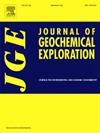Modelling the paleopedological development of loess/palaeosol sections using discriminant function analysis of compositional geoscience data, case study in Eastern Croatia
Abstract
Previous studies on the mineralogical differentiation of Pleistocene loess/palaeosol sections focused on the description and source material of four loess/palaeosol sections located on the eastern border of Croatia along the Danube: Zmajevac, Zmajevac I, Erdut and Šarengrad. The authors demonstrated the decreasing influence of the Danube and the increasing influence of the rivers draining the Central Bosnian Mountains of the Dinaric Ophiolite Zone both important source areas for aeolian sediments at the southern edge of the Carpathian Basin that transport material from the Central Bosnian Mountains. The aim of this research is to identify the palaeoclimatic factors that influenced the pedogenetic development of the studied palaeosols. The model was created based on the research results of the same four loess/palaeosol sequences in Eastern Croatia. This model can also be applied in other locations to determine the influence of certain climatic factors on the degree of pedogenetic development of individual palaeosols. The loess/palaeosol sequences were divided into eight comprehensive groups (horizons) based on their genesis, degree of pedological development and/or position in the soil profiles. The explanation of the typical patterns occurring between the studied horizons is based on the construction of a Discriminant Function Model (DFM) resulting from the analysis of the compositional data (CoDa) of the geochemical (major and trace elements) and granulometric (grain size) data of the loess/palaeosols in combination with external variables such as weathering coefficients and chemical soil properties. In the final phase, the DFM was transformed from structural (mathematical) to functional (process) terms. This revealed that three main themes dominate the formation of Pleistocene loess/palaeosol sequences: 1) the separation of well-developed palaeosols from parent material; 2) the separation of automorphic palaeosols from hydromorphic soils exposed to post-pedogenic waterlogging conditions; and 3) the differentiation of horizons (soils and alluvium) formed by the redeposition (by water or mudflows) of previously deposited aeolian material, regardless of whether and to what extent it was exposed to post-sedimentary pedogenesis.

 求助内容:
求助内容: 应助结果提醒方式:
应助结果提醒方式:


